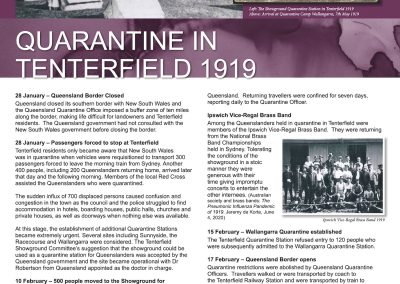Isolation and community restoration in Tenterfield
Contributed by Ian Unsworth
In 2002, I moved from medical practice in Sydney to a house on a large block next to the local Tenterfield Hospital.
My interest was piqued by a small building at the hospital’s rear, which I was told was an isolation ward built for the ‘Spanish’ influenza pandemic of 1918–19. This began a project to restore and preserve the building, and to create a museum to the Spanish flu pandemic which has taken almost 17 years.
In late 1918, plans for a four-room isolation ward plus nurse’s duty room were drawn up. They were signed off by the well-known state architect, George McCrea, on 23 December 1918. The model used was one based on the Nightingale principles of fresh air and sunlight.
Since its completion in early 1920 – too late for the pandemic in Australia – the rooms of the isolation ward and adjoining ablution block has had several uses. Initially it was used for infectious disease isolation, but vaccines reduced the need so it became nurse accommodation, then finally a workshop. After closure in 2003 it rapidly deteriorated through disuse, pests and weather.
The National Trust (NSW) declined my first register application in 2004, but later with help from heritage specialist Jennifer McMonnies, the ward block was accepted on the State Heritage Inventory in 2008. The Tenterfield Shire Council Local Environmental Plan followed, and eventually the isolation ward was added as a Section 170 listing on the State Heritage Register.
In 2017 I applied for and was awarded a NSW HeritageNearMe grant of $100,000 and by the end of 2018 the ward had been restored.
With invaluable help from the Tenterfield Heritage and Museum Advisers, I have worked on creating the Museum of the Spanish Flu Pandemic 1918–19 in the very building erected for victims of that pandemic.
The museum is now completed and interpretive panels cover the major topics of the pandemic. These include what it was, where it came from, and its effects on Australia, NSW and Tenterfield. Also included are the border issues between states, especially Queensland and NSW, plus the Tenterfield Quarantine Camp.
I have been most fortunate to have had a wonderful and supportive group of volunteers from the Tenterfield Community. They realised what a loss the destruction of the block would have been. Originally planned for demolition in a proposed hospital upgrade, the building and its history have now been preserved for generations to come. It is believed this is the only such isolation ward extant in regional and rural Australia to-day.


